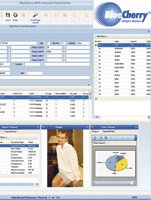The ABCs of ERP: Enterprise Resource Planning Gets Down to Basics
With the pressure of speed to market, an increasingly global industry, multiple sales channels including the Internet, not to mention a host of other issues making the apparel industry more competitive and challenging than ever, technology is not a luxury but a necessity. At least that’s how the more savvy businesses see it.
A Virtual Necessity
“Over the years we’re seeing startups by serial entrepreneurs who’ve rolled out businesses that have gone public, and they know they need to start with some kind of system,” says Jon Walker, president of Portland, Oregon–based Ensemble Business Software. “And the technology has come down to the level where you don’t have to, for budgetary reasons, limp along on bad software.”
According to Walker, new companies are increasingly working computer software into their startup costs, considering it as vital as great products and skilled employees. “Especially in the last five years, we see a real change in the low end of the market,” says Walker. Prices have come down and recognition of software’s benefits is up.
This convergence has led to companies investing hundreds of thousands of dollars in Product Lifecycle Management for the front end of their businesses, and Enterprise Resource Planning for the back end.
ERP attempts to integrate a company’s data and processes under a unified system comprised of various modules, which address such issues as quality control, cost management, inventory, supplier scheduling, accounts payable and receivable, human resources, and customer service.
The price and acceptance convergence has made the market saturated with ERP providers, says Walker, whose clients include Everlast and Sweater.com, which owns the brand One Girl Who.
Although ERP benefits companies of all sizes, Walker says once a company is making $10 million in annual revenues, ERP is a virtual necessity. “We learned a long time ago that small apparel companies have the same requirements in ERP systems as large companies,” he says. Ensemble Business Software’s solutions offer the same functionality for companies large and small, and start at $50,000.
This year the company began prospecting smaller clients. “We’re trying to let these people know they have alternatives,” says Walker. “Typically at the low end of the market you see people struggling with low-end-apparel ERP that’s not sophisticated financially.”
Sweater.com, for example, was struggling with an off-the-shelf accounting package that was not integrated with its other software programs, says Walker, crimping the flow of information.
Integration and Efficiency
When new companies are launched, they typically rely on inexpensive programs like Excel and Quickbook, “smaller financial applications that aren’t fully integrated,” says Paul Magel, senior vice president, application solutions, for New York–based Computer Generated Solutions. The other common scenario is companies trying to get by with pieced-together in-house programs, “and they now want a packaged software product from a commercial vendor.”
The payoff for investing in ERP is “control of your business,” says Magel, “and the benefits really come from there.”
PLM tends to stop when the product development process has been completed, and ERP typically takes over from there. Some PLM applications have an ERP element to them, and vice versa. Generally companies wanting both can have the two systems integrated, even if they’re from different providers.
ERP is especially efficient in handling orders received via Electronic Data Interchange, says Magel. “All the major retailers send electronic orders, which our system pulls in automatically and determines what those orders are.”
CGS’s ERP product is called BlueCherry and starts at $3,500 per concurrent user, or the number of people who will be using the system at the same time. The software was built specifically for the apparel industry, Magel stresses. CGS has serviced over 1,000 clients and boasts a current roster of 200, including Tommy Bahama, Sean John, and Rocawear.
All clients use the same version of the software, and BlueCherry has an active user community. CGS holds an annual user group meeting in Las Vegas where customers can exchange ideas. CGS also has a customer advisory panel that meets on a monthly basis. “They help push us forward as far as where our products are going,” says Magel.
Recently, CGS has added collaborative sourcing, a new Web-based module that allows companies and their overseas suppliers to exchange real-time updates. BlueCherry Extender, which allows user customization, is also new.
Systematic Solutions
“Organizations are made and lost based on financial performances,” says Robert McKee, strategy director for fashion for Minnesota-based Lawson. And while that has always been the case, McKee says a month-end closing is no longer a viable option. “How you did is really historical information, it’s not operationally significant. Immediate real-time financials tell you how you’re doing, not how you did.
“ERP gives you the ability to make the right decisions,” he continues. “You can still make stupid decisions, but you have to go against the grain of what the system is telling you.”
Lawson’s ERP has several elements that differentiate it from others, McKee says. Many systems categorize products based on style/color/size, but if you have a product that doesn’t follow those categories, you have to “trick the system” because the style/color/size logic is so deeply built in. In 1992, Lawson landed global luxury brand Hermeacute;s as a client, which makes crystal and housewares in addition to apparel. As a result, Lawson’s ERP allows users to track items by SKU number if they don’t fall into style/color/ size categories.
Lawson’s software, called M3, also offers fully integrated demand planning to help users design and manufacture closer to the point of demand. In addition, it is designed to track basic items in a clothing line that need constant replenishing, in the process decreasing inventory levels and the likelihood of markdowns. “You’re using your supply chain to replenish your shops,” explains McKee, “rather than your distribution centers.” The concept behind this is for a company to achieve the ideal state of never being out of stock in an item while simultaneously avoiding large inventory commitments.
And then there’s the industry trend of the erosion of traditional seasons and the need for a steady flow of new product. To do this, software is mandatory. “If it was difficult to control two seasons,” says McKee, “how are you going to control 20 seasons? The ability to control this vast explosion of SKUs, styles, merchandise, seasons is not something you can handle without adding a tremendous number of people or a system that can support you with logical flows of information.”
McKee declined to offer a price range for M3, but said, “We have the lowest total cost of ownership of any ERP vendor.”
Identifying the Needs
Thinking of investing in Enterprise Resource Planning software? Here’s what the process will be like, according to John Murphy, president of Glendale, Calif.–based Murphy & Associates, creators of ApparelMagic, whose clients include Von Dutch.
During the assessment phase, ApparelMagic identifies the software a company is currently using and what problems or inefficiencies it is causing. After the software comes the people side of the equation. “There’s a lot of focus on personnel,” says Murphy, “and whether there needs to be retraining of job functions to marry better with the ERP system.”
Sometimes two job functions are combined into one, while other times one set of duties is split into two. This is very important, “so they don’t find six months later they’ve got three people doing the same thing and are no more productive than they were.”
Since ERP is designed to make a company more efficient, rarely does it require new personnel to be hired. Sometimes it does require that certain employees be laid off, however.
ApparelMagic next looks at how information is shared via paper and e-mail. “If people are using e-mail to notify others that a purchase order is ready, well, don’t send an e-mail, just have the person access the information directly in the system, then you can cut out that e-mail and cut two or three hours of whatever it is you’re doing per day.”
What a company doesn’t know is also vital. “We ask, ’Are you in the dark about your fabric requirements? Can you tell me how much you sold last month?’ We’re looking for holes in knowledge so we can supply them with the benefits of using ERP.”
Assessment can take up to 10 days with a small company, and up to three months with a large organization. ApparelMagic systems typically cost $5,000 to $100,000, says Murphy, depending on the size of the company.
Implementation of the ERP system can be done the way a company requests, or on the advice of ApparelMagic. Common scenarios include implementation being done all at once, such as when a company changes locations. It can also be done more gradually, with new sales transactions going into the new system, while old transactions remain in the previous system.
Training is typically done one department at a time, with employees budgeting a couple of hours of their day to focus on learning the new system. Often a company will wait until a slow month for implementation and training, which usually takes one to four weeks.
Finally, ApparelMagic closely monitors support questions, looking for redundancies. If the same question is being asked over and over, then further training is required.
ApparelMagic also offers follow-up consultative training, says Murphy, in which it looks at “not just how do you use the system, but how should you use the system.”























